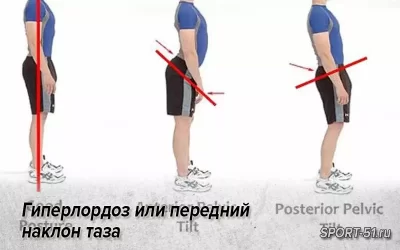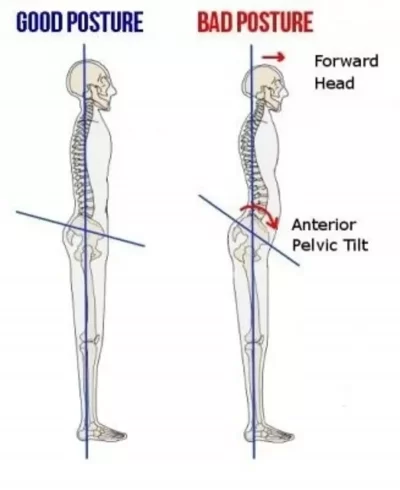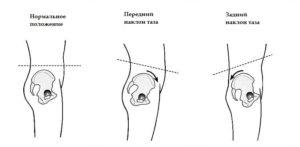Step 5: Correct back holding for compound movements
- 4 exercises to correct anterior pelvic tilt
- Causes of anterior pelvic tilt
- Let's find out if a tilted pelvis is that bad and when to look out for it.
- So how did you come up with this idea?
- Hyperlordosis or anterior pelvic tilt
- Causes of an anterior pelvic tilt
- This exercise is designed to increase the length of the hip flexors.
- Lower your straight or bent legs without lifting your back off the floor
- Causes of anterior pelvic tilt
- Exercises to correct anterior pelvic tilt
- Exercise 1: Stretching the hip flexors
- Exercise 2: Lower your straight legs without lifting your back off the floor
- Number of repetitions and repetitions
- Tighten your glutes for all exercises.
- What is an anterior pelvic tilt?
- What Causes Anterior Pelvic Tilt?
- What is an anterior pelvic tilt?
- What causes an anterior pelvic tilt?
- Exercise 3: Leg Extension Bridge
- Exercise 4: Rotate the pelvis backwards
- Which doctor should I see?
- Why is it important to see a doctor on time?
4 exercises to correct anterior pelvic tilt
Anterior pelvic tilt is one of the most common postural disorders. It's easy to spot if you look at a person from the side. The two most important visual clues are a large difference between the height of the anterior and posterior hip spine and excessive lumbar lordosis.
The pelvis is the structure that connects the torso and legs. The main movements of the pelvis are rotation and flexion. As the pelvis tilts forward, lumbar lordosis increases and the hip joints begin to flex.
To determine if you have anterior pelvic tilt, stand with your back against a wall and measure the distance between your lower back and the wall. With a 'normal curve' in your lower back, there should be enough space between it and the wall for your hand to fit through. The correct forward lean is 4-7 degrees for males and 7-10 degrees for females. If the distance between the wall and your hand is greater than the thickness of your hand, your pelvis is likely tilted forward.
Causes of anterior pelvic tilt
Shortening of the hip flexors can cause this type of dysfunction. This type of shortening can be caused by prolonged sitting, improper training, and trauma. When such a person stands up, the shortened muscles pull the pelvis into an anterior tilt, resulting in an increase in lumbar lordosis.
There is currently no research confirming a direct link between excessive lumbar lordosis and low back pain. However, there is one study that shows a reduction in hip extension and internal and external rotation in patients with chronic non-specific low back pain [1]. We all know that by restricting hip flexion, there is a compensatory increase in lumbar lordosis. By treating the hip-pelvic-lumbar complex as a whole, we can help the patient significantly.
From an aesthetic point of view, there is no particular advantage in tilting the pelvis forward, as the abdomen then appears larger than it actually is.
Let's find out if a tilted pelvis is that bad and when to look out for it.
In 2011, Herrington L. (1) conducted a study to determine how common this dreaded phenomenon is, specifically anterior pelvic tilt. The result: 85 male % and 75 female % have anterior pelvic tilt, while 6 male % and 7 female % have posterior pelvic tilt. Overall, 91 men's % and 82 women's % do not correspond to the 'norm'. From this it can be concluded that anterior pelvic tilt is normal and should not be viewed as an absolute evil.
But is there a connection between anterior pelvic tilt and back pain?
For decades, many specialists have dealt with this question and published just as many works on this topic. The goal of all these studies was to find an association between anterior pelvic tilt (including hyperlordosis) and back pain.
Some have shown that this connection does not exist, others that it is very weak!
doi: 10.4184/asj.2014.8.5.565
doi: 10.1007/s00586-013-2787-4.
DOI: 10.2519/jospt.2002.32.9.447
This means that some anterior pelvic tilt is normal. It does not lead to pain in the back or anywhere else.
So how did you come up with this idea?
First, because such a relationship between posture, stress, and symptoms seems logical. However, research shows that this logic is flawed. Many people with 'normal' posture develop back pain, but those with abnormal posture do not.
In my opinion, taking posture out of the order is worth it. It can be left as a factor that increases exposure but does not necessarily lead to the development of symptoms.
Hyperlordosis or anterior pelvic tilt

Anterior pelvic tilt is one of the most common postural disorders. It's easy to spot by looking at a person from the side. The two most important clues are: a large height difference between the anterior and posterior hip bones, excessive lumbar lordosis, and an almost level buttocks.
The pelvis is the structure that connects the torso and legs. The most important movements of the pelvis are rotation and flexion. As the pelvis tilts forward, lumbar lordosis increases and the hip joints begin to flex.
To determine if you have anterior pelvic tilt, stand with your back against a wall and measure the distance between your lower back and the wall. With a 'normal curvature' of the lower back, the space between it and the wall should allow for the passage of the hand. In males, the correct anterior slope is 4-7 degrees, in females - 7-10 degrees. If the distance between the wall and your hand is greater than the thickness of your hand, your pelvis is likely tilted forward.
Causes of an anterior pelvic tilt
Shortening of the hip flexors (iliopsoas and rectus femoris) and lengthening of the posterior surface of the thighs can cause a similar dysfunction. This shortening can be caused by prolonged sitting, improper exercise, or trauma. When the person stands up, the shortened muscles pull the pelvis forward, causing an increase in lumbar lordosis.

There are several components that must work together to return the pelvis to its original position:
- Shortened hip flexors and lengthened posterior legs;
- weak abdominal muscles;
- tight lower back muscles;
- Weak glutes.
This exercise is designed to increase the length of the hip flexors.
Try to tighten your abs and glutes with this exercise - avoid tightening and sagging your lower back.
- Stand on the knee of your right foot. The left foot is on the footrest.
- Swing your whole body forward until you feel a pull at the front of your hips (closer to the hip joint). Avoid increasing your lumbar lordosis.
- The feeling of stretching should not be extremely strong. Maintain fixation for 3 to 5 minutes on each side.
- To increase the effect on the more distant fibers of the quadriceps muscle, bend the leg at the knee joint. You can do this by placing something under your ankle or by propping your leg against a wall.
Lower your straight or bent legs without lifting your back off the floor
- First, lie on your back and put your feet up. Press your lower back and sacrum firmly to the floor.
- Lower both feet down until your lower back is pressed to the floor.
- Return to the starting position and perform two sets of 20 repetitions each.
Causes of anterior pelvic tilt
Shortening of the hip flexors can cause this type of dysfunction. This shortening can result from prolonged sitting, improper training and trauma. When such a person stands up, the shortened muscles pull the pelvis into an anterior tilt, causing an increase in lumbar lordosis.
There is currently no research confirming a direct link between excessive lumbar lordosis and low back pain. However, there is one study that shows a reduction in hip extension, internal rotation, and external rotation in patients with chronic nonspecific low back pain. We all know that by restricting hip flexion, compensatory lumbar lordosis increases. By treating the hip-pelvis-lumbar spine complex as a whole, we can help the patient significantly.
From an aesthetic point of view, an anterior pelvic tilt has no particular advantage, since the abdomen then appears larger than it actually is.
Exercises to correct anterior pelvic tilt
There are several elements to work on to bring the pelvis back to its original position.
In my practice, I have selected four exercises to correct anterior pelvic tilt. One for each of the above points. These exercises are effective for both stretching some muscles and strengthening others. They are easy to perform as they do not require any special equipment.
Exercise 1: Stretching the hip flexors
This exercise is designed to improve hip flexor length. Try to tighten your abs and glutes during this exercise.
1 Stand on the knee of your right leg. The left leg is placed on the foot. In technical terms this position is called – on the knee and the foot
2 Swing your whole body forward until you feel a pull at the front of your thigh (near the hip joint). Avoid increasing your lumbar lordosis.
3 The feeling of stretch should not be extremely strong. Maintain fixation for 3 to 5 minutes on each side.
4 To increase the effect on the distal fibers of the quadriceps muscle, bend the back leg at the knee joint. You can do this by placing something under your ankle or by propping your leg against a wall.
Exercise 2: Lower your straight legs without lifting your back off the floor
1 First, lie on your back and raise your legs straight. Press your lower back to the floor.
With knees straight, lower both legs until your lower back touches the floor.
3 Return to the starting position and do two sets of 20 repetitions each.
It is very important to keep your lower back on the floor. When your back lifts off the floor, your abdominal muscles stop working and instead you overwork your already tight hip flexors. It can be helpful to keep your hand between your lower back and the floor to ensure your back stays on the floor. By strengthening your abs, you can lower your legs without lifting your lower back off the floor.
Number of repetitions and repetitions
When learning all of these exercises, avoid high-rep sets as they will lead to fatigue (and ruin technique). It's better to do more sets of a small number of quality reps without tilting the pelvis forward.
The same goes for Paul's parallel bars - less volume and more intensity. You only need to hold 10 seconds at a time, but with proper technique, if you're really trying to tighten your abs and glutes as much as possible by tilting your pelvis back. Do 2-4 sets with breaks of at least 30 seconds.
Tighten your glutes for all exercises.
It pays to do this not only with squats and deadlifts, but with any other exercise as well. If forward pelvic tilt has become a serious problem, you should work on eliminating it in bench presses and even biceps and triceps exercises as well. And, of course, the maximum contraction of the glutes should be the last effort in deadlifts, squats, bridges, and other exercises.
1. What Causes Excessive Forward Tilt of the Pelvis?
As mentioned at the beginning, lordosis is usually caused by a shortening and tightness of the hip flexors. However, it can also be a combination of factors: weakness and 'disabling' of the glutes and biceps, weak abdominal muscles and an overstretched lower back.
In some cases, forward pelvic tilt is genetic and has nothing to do with the strength/length of specific muscles. Or it develops as a result of a specific training approach, e.g. For example, in athletics, forward pelvic tilt can be useful [3]: short hip flexors and stretched biceps thighs help you run faster and jump higher.
The situation is similar with weightlifters, as Bret Contreras states [4]. However, it's important to remember that hyperlordosis transfers the load from the sleeping gluteus maximus to the overextended lower back.
The extent to which forward pelvic tilt affects an individual's technique and health should be assessed on a case-by-case basis.
2. Why don't tight hip biceps tilt the pelvis backwards?
Although the hip biceps are usually stretched and relaxed when the pelvis is tilted forward, they can appear tight and should pull the pelvis back. As trainer and physical therapist Mike Reynold explains [5], shortened and tight hip flexors cause the pelvis to tilt forward, leaving even healthy and strong biceps in a constantly stretched position, creating a 'cramped' feeling. This makes it difficult for us to bend forward and try to touch the ground with our toes, for example.
3 Can hyperlordosis cause back pain?
What is an anterior pelvic tilt?
If you have this attitude and no other:
You have what is known as an anterior pelvic tilt.
Some believe this is due to weak and overstretched muscles, leading to back pain, injuries, and other spinal disorders. And for such people it is contraindicated to work out in the gym.
Others feel this is normal and cannot be changed, so there is nothing to worry about.
In short, the forward tilt of the pelvis is one of the variants of the normal structure of the human body. In most cases, it is not a cause for concern. The only problem is an abnormal posture that can be easily corrected.
Pelvic obliquity is determined by where the hips are tilted in relation to the body - forward or backward.
And here's another diagram showing your hip bones at the same angle:
As you can see, two points are of particular interest:
The posterior superior iliac spine or PSIS.
What Causes Anterior Pelvic Tilt?
Most people believe that forward pelvic tilt is caused by an imbalance between the muscles of the back and the muscles of the front of the pelvis (hips). The back muscles are stronger than the thigh muscles.
This seems plausible since the pelvis is equipped with several powerful muscles and ligaments, including the glutes, biceps, hip flexors, and abdominals. If one or more of these muscles are noticeably stronger than the rest, it can lead to poor posture.
As such, it is often claimed that people with anterior pelvic tilt have weak glutes, biceps, hip flexors, or abdominal muscles, leading to an imbalance known as Cross Syndrome, which looks like this
The problem with this theory is that it contradicts physiology, since anterior pelvic tilt is a variant of normal human anatomy.
For example, in a study of 120 people, 85 male % and 75 female % had some degree of forward pelvic tilt, but no back or hip pain. The study also showed that most people have a pelvic tilt of around 12-13 degrees.
You might think that just because this tendency is so common doesn't mean it's normal.
However, other studies have shown that there is no connection between muscle strength and pelvic position, so one has to wonder if the muscles affect the angle of inclination at all.
It's also unlikely to increase your risk of injury or pain while exercising.
The angle of pelvic tilt changes with different exercises. So if your hips are in a neutral position when you're standing, that angle changes when you squat, walk, run, or bike.
What is an anterior pelvic tilt?

If you have this attitude and no other:
then you have what is called an anterior pelvic tilt.
Some people believe that this is caused by weak and overstretched muscles, leading to back pain, injuries, and other spinal ailments. It is contraindicated for such people to train in the gym.
Others feel this is normal and cannot be changed, so there is nothing to worry about.
In short, the forward tilt of the pelvis is one of the variants of the normal structure of the human body. In most cases, it is not a cause for concern. The only problem is an abnormal posture that can be easily corrected.
Pelvic obliquity is determined by where the hips are tilted in relation to the body - forward or backward.


And here's another diagram showing your hip bones at the same angle:

As you can see, two points are of particular interest:
The posterior superior iliac spine, or PSIS.
The anterior superior iliac spine, or ASIS.
If you draw a line between ASIS and PSIS, you get the pelvic angle.
When the ASIS is lower than the PSIS, it corresponds to an anterior pelvic tilt, when the opposite is the case, to a posterior pelvic tilt, and when they are approximately equal, to a neutral pelvic tilt.
What causes an anterior pelvic tilt?
Most people believe that anterior pelvic tilt is caused by an imbalance between the muscles of the back and the front of the pelvis (hip). The back muscles are stronger than the thigh muscles.
This is likely because the pelvis is equipped with several powerful muscles and ligaments, including the glutes, biceps, hip flexors, and abs. When one or more of these muscles are noticeably stronger than the others, poor posture can result.
Therefore, it is often said that people with an anterior pelvic tilt have weakness in the glutes, biceps and hip flexors, or abdominal muscles, leading to an imbalance known as junction syndrome, which looks like this:

The problem with this theory is that it contradicts physiology, because anterior pelvic tilt is a variant of normal human anatomy.
For example, in a study of 120 people, 85 male % and 75 female % had some degree of anterior pelvic tilt but no back or hip pain. The study also showed that most people have a pelvic tilt of around 12-13 degrees.
You might think that just because this tendency is so common doesn't mean it's normal.
However, other studies have shown that there is no link between muscle strength and pelvic condition, so one has to wonder if muscles affect incline at all.
It's also unlikely to increase the risk of injury or pain during exercise.
The angle of pelvic tilt changes with different exercises. So if your hips are in a neutral position when you're simply standing, that angle changes when you squat, walk, run, or bike.
What is the cause of this suffering?
Scientists haven't figured that out yet. The current most common hypothesis is that the condition is caused by the shape of the pelvis itself, which varies from person to person.
Exercise 3: Leg Extension Bridge
1 Lie on your back. Bend both legs at the knee joints.
2 Raise your pelvis as high as possible. Keep your shoulders on the floor. 3.
3. Straighten one leg in this position and hold it for 5 seconds.
4. Bring that leg back to the starting position and do the same with the other leg.
5. Then return to the starting position and perform 2 sets of 10 reps.
This exercise works the glutes by contracting the muscles in the anterior abdominal wall. There should be no body rotation and/or hip flexion of the standing leg during the exercise.
Exercise 4: Rotate the pelvis backwards
This exercise is very important. It is necessary to perform this exercise while standing, since dysfunction occurs in this position. The ability to control pelvic position while standing is an important factor in improving posture.
1 Stand with your back against a wall, heels shoulder-width apart.
2 Press your lower back against the wall, as well as your hips and shoulders. Keep your knees straight.
3 Hold this position for ten seconds, and then relax. Repeat the exercise 10 times.
This exercise engages the abdominal and gluteal muscles. You can place your hand between your lower back and the wall for control. This hand position will help you determine how well you're performing the move. You can place your other hand on your abdomen to feel the anterior abdominal wall muscles work.
Which doctor should I see?
A doctor's visit is essential if the pain persists for a long time and is accompanied by fever, numbness in the lower limbs, nausea, or if it is caused by an injury. If you want to be sure that you will receive a good diagnosis and quality treatment, come to the CELT Clinic. You don't have to live in Moscow to become our patient and get rid of pain syndrome. Simply contact your doctor who will refer you to one of our specialists depending on the type of pain, its cause and the symptoms you are experiencing:
- a pain specialist;
- an orthopaedist/traumatologist
- rheumatologist
- neurologist
- Oncologist;
- physiotherapist;
- Gynecologist;
- Urologist.
Why is it important to see a doctor on time?
Symptoms of pain in the pelvic area can indicate a number of diseases of the genitourinary system, the musculoskeletal system and the gastrointestinal tract. Taking painkillers only temporarily relieves symptoms, but does not eliminate the cause - and the disease continues to progress, which is dangerous for health and life. By visiting the doctor in a timely manner and conducting diagnostic tests, the patient learns the cause of the pain and, together with the doctor, can focus on eliminating it in order to avoid more serious consequences, irreversible processes, and sometimes surgery. Under no circumstances should you put off seeing a doctor if
- your pain symptoms are intense and getting worse;
- blood in the urine or stool;
- your internal organs feel pain;
- headache, nausea or high body temperature occur;
- women have bleeding from the uterus.
- The flexor muscles of the foot.
- On half-bent legs.
- lower leg flexion.
- Lift your heels off the floor during the squat.
- Long flexor muscle.
- muscle work while running.
- muscles in the legs.
- Which muscle extends the lower leg and flexes the thigh.
